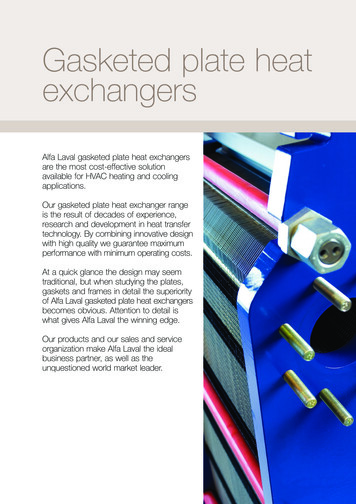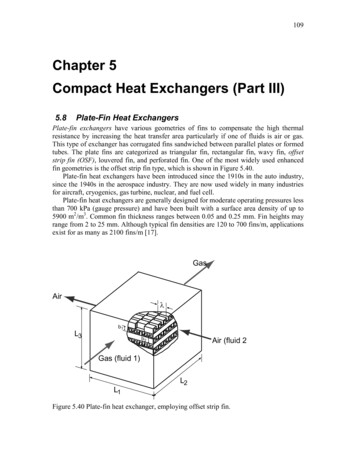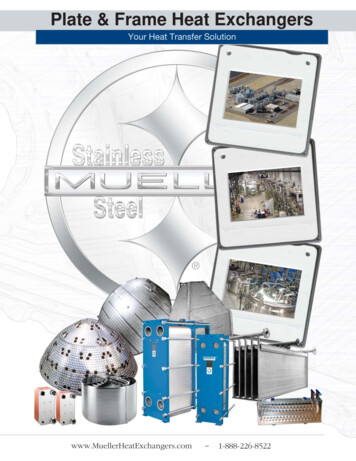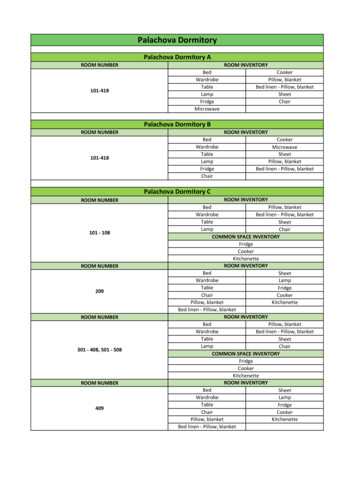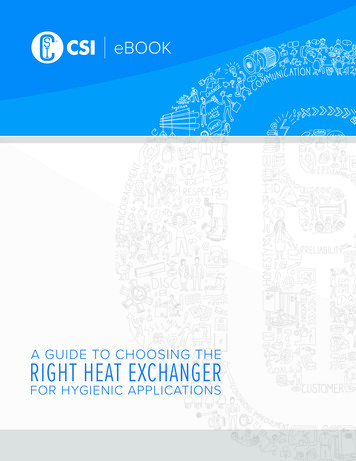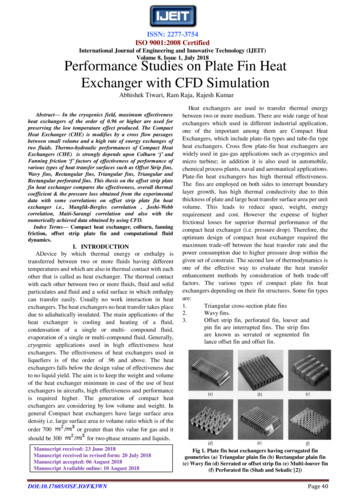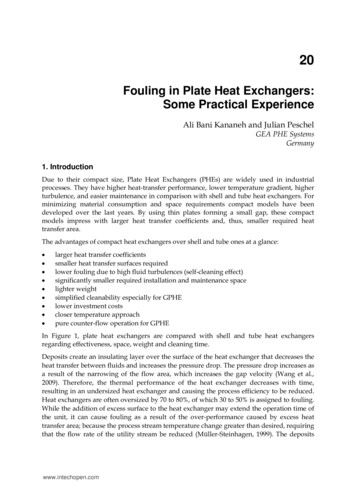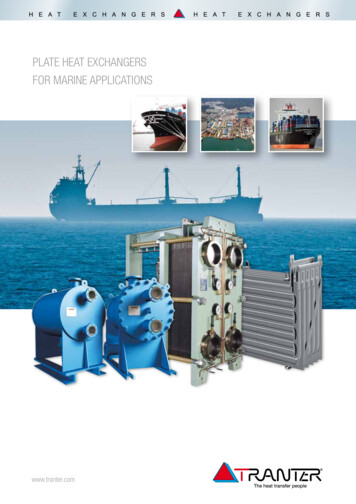
Transcription
865A publication ofCHEMICAL ENGINEERING TRANSACTIONSVOL. 88, 2021The Italian Associationof Chemical EngineeringOnline at www.cetjournal.itGuest Editors: Petar S. Varbanov, Yee Van Fan, Jiří J. KlemešCopyright 2021, AIDIC Servizi S.r.l.ISBN 978-88-95608-86-0; ISSN 2283-9216DOI: 10.3303/CET2188144Pillow-Plate Heat Exchangers: an Overview on Advances,Limitations and ProspectsMarco Vocciantea,*, Eugeny Y. KenigbDCCI, Dipartimento di Chimica e Chimica Industriale, Università degli Studi di Genova, Via Dodecaneso 31, 16146,Genova, ItalybChair of Fluid Process Engineering, Paderborn University, Pohlweg 55, Paderborn 33098, Germanymarco.vocciante@unige.itaPillow-plate heat exchangers (PPHEs) represent an innovative and promising alternative to conventionalequipment. The waviness of the pillow-plates promotes lateral mixing and turbulence, which results in a goodthermo-hydraulic performance, offering a significant energy-saving potential. Since PPHE also offer severalimportant structural and cost related advantages over conventional heat exchangers, e.g. compact, light andpressure-resistant construction, low pressure drop on the product media side, as well as low capital andoperating costs, their use in process industries is growing. However, the implementation of PPHE is still limiteddue to the lack of comprehensive data and publicly available proven design methods, while their range ofapplicability has not yet been fully determined.The purpose of this contribution is to present the current state of the art of PPHE, with particular attention torecent advances in terms of modelling and prediction of the performance of such equipment, while highlightingthe advantages in terms of sustainability and efficiency of the various applications compared to conventionalsolutions. In addition, the future prospects in modelling and application of these devices will also be delineated.1. IntroductionIn recent decades, increasing attention has been paid to the sustainability of products and processes, fosteringpossible improvements aimed at maintaining a balance between the exploitation of resources and theimprovement of the quality of life of modern human society.In this context, thermal energy recovery represents a key aspect for the sustainable design and operation ofprocessing plants, as minimizing energy consumption translates into reduced environmental impacts and costs.Heat recovery in an industrial process takes place through the heat recovery system, a set of units i.e. heatexchangers – designed to meet the process thermal demands – where exchange of thermal energy betweentwo or more mediums occurs. As heat exchangers are essential in the operation of many systems (Chew et al.,2015), increasing the efficiency and reliability of heat exchangers represents a crucial matter to enhance theoverall systems performance and reduce anthropogenic footprint.Heat exchangers can be divided in two main categories on the basis of their functioning: i) direct heat exchanger,where the exchanging mediums are in direct contact (e.g. cooling towers); and ii) indirect heat exchanger, wheresuch mediums are separated by thin conducting walls to prevent mixing. Many types of technical solutions havebeen developed, like shell-and-tube (vertical/horizontal), plate (gasketed, welded etc.) and micro heatexchangers.Since decades, the most spread solution in process industry is represented by shell-and-tube heat exchangers(STHE). This is because such equipment is suitable for a wide range of operating conditions thanks to theirrobust and flexible as well as easy to build design, which made them exchangers with well-known performances.However, they lack compactness and exhibit low heat transfer rates for a given Reynolds number, due to thepresence of stagnant zones, which turn into a loss of useful exchange surface. In contrast to STHE, plate heatexchangers (PHE) are compact, lightweight, flexible in size and provide large overall heat transfer coefficients,but they suffer from generally limited operating ranges of pressures and temperatures (Shah and Sekulic, 2003)and tend to have other complications depending on the adopted technical solutions (e.g. leak tightness issuesPaper Received: 9 May 2021; Revised: 4 July 2021; Accepted: 17 September 2021Please cite this article as: Vocciante M., Kenig E.Y., 2021, Pillow-Plate Heat Exchangers: an Overview on Advances, Limitations and Prospects,Chemical Engineering Transactions, 88, 865-870 DOI:10.3303/CET2188144
866for gasketed PHE or difficulty in cleaning when welded). Nevertheless, PHEs can represent an economicmethod in various industries to both increase the thermal efficiency and decrease the fuel demand by wasteheat recovery (Lianzheng et al., 2019), also thanks to different possible flow arrangements.Since the first plate heat exchanger appeared in the late 20th century, many advancements and improvementshave been done on PHEs design and manufacture (Ayub, 2003). However, to further increase sustainability ofboth process plants and equipment units, and reduce energy consumption, more efficient heat transfer systemswith optimized design are needed (Hesselgreaves et al., 2016). This prompted research efforts on developmentof advanced geometries and enhanced surfaces for different equipment types to yield higher HE coefficients.From the geometrical point of view, different configurations have been conceived to increase the thermalperformance of PHEs. Solutions experimentally and numerically investigated included multi-layers and multichannels with different flowing fluids (Malinowski et al., 2019) and/or resorting to mini- and micro-channels(Shyam et al., 2018). As regard surface enhancements, in addition to increase the plate efficiency by increasingturbulence, some solutions like corrugation patterns also produce a self-cleaning mechanism, which reducesfouling propensity and helps to diminish clogging problems deriving from their small flow passages. The mostcommon surface pattern used is the chevron design (Abou Elmaaty et al., 2017).Among the various types of compact heat exchanger with different geometrical configurations, gasketed andcorrugated plate heat exchangers are known for their high thermal efficiency (Tabares et al., 2019). In thisequipment, a number of gasketed plates constrained between an upper carrying bar and a lower guide bar arecompressed between the fixed frame and the movable frame by using many tie bolts. Based on this, novelcorrugated plate heat exchanger (CPHE) were studied both numerically and experimentally (Al Zahrani et al.,2020), also including the effect of geometrical parameters (pitch, depth, and angle of corrugation) on the thermalperformance of the system (Wang et al., 2017).Another solution is represented by welded plate heat exchanger (WPHE), a stack of corrugated plates weldedto one another to create the flow passages for the exchanging fluids. Also in this case, plates are corrugated tocreate high turbulence and wall shear stress, thus increasing the thermal performance for the same exchangesurface. WPHE construction features grant higher operating temperatures and pressures and make it suitablefor multi-stream applications (Martínez-Rodríguez et al., 2020). Investigations on the use of WPHE also indicatesuperior overall thermal performance in terms of fouling mitigation (Tamakloe et al., 2013), making it an attractiveoption in heavy duty applications. The type of surface corrugation and the number of passes are critical elementsto consider for the optimal design of this equipment (Arsenyeva et al., 2016).The constant search for more efficient solutions, granting more efficient heat transfer surfaces with reducedpressure drop and low production cost, resulted in an innovative design of WPHEs, the so-called pillow-plateheat exchangers (PPHEs). They are characterized by a pillow-like surface and fully welded construction (leaktightness). This turns in a similar heat transfer performance compared to other PHE solutions, but using lessmaterial and a reduced volume. For instance, the low weight and compactness of pillow-plates make them idealas condensers (PPC) in distillation applications, in which they can be implemented directly into the column head.In this sense, PPHEs represent a highly sustainable equipment, as they contribute to increasing energy savingswhile reducing the environmental impact compared to other PHEs (Arsenyeva et al., 2019a).PPHEs have a great flexibility compared other types of heat exchangers. One of the key aspects induced bytheir particular structure is the possibility of having channels with different cross-sectional area for hot and coldfluids. However, the great variety of constructive and operational parameters that characterizes a PPHE has tobe further optimized to compete and exceed the efficiency and compactness of other high efficiency PHEs.Indeed, in spite of the advantages, PPHEs market penetration is currently still slow, mainly due to the lack ofcomprehensive design principles and the existence of considerable uncertainties in the dimensioning of suchapparatuses (Piper et al., 2015a). Yet, in recent years the situation has been progressively changing.This review aims to gather current knowledge on these innovative heat exchangers, illustrating their structure,thermal performance and heat transfer enhancement mechanisms, as well as their advantages and limitations.Also, PPHEs recent advances and prospects for improvement will be discussed.2. PPHE structure and geometryA pillow-plate consists of two overlapping sheets of metal (usually stainless steel), spot-welded together with aspecific pattern and seam-welded along the edges mainly by laser or TIG welding process without metal filling(Arsenyeva et al., 2019a). By means of inlet and outlet nozzles, these sheets are then expanded from the insideby hydroforming, i.e. with the aid of an incompressible medium such as water, assuming their characteristicpillow-like structure (Piper et al., 2015a).Depending on the thickness of the sheets, this process can result in the production of "single embossed" pillowplates (only one sheet is deformed if it is much thinner than the other), useful for making e.g. pillow-plate jacketvessels, or “double embossed” (symmetrical) pillow-plates, mainly used for the design of PPHEs, where several
867pillow-plate panels are adjusted together with a certain distance from each other to form a package and insertedinto a housing. This arrangement determines an internal flow path IC (inner channel) between the welded sheetsof the pillow-plates and an external flow path OC (outer channel) identified by the space between adjacentpillow-plates (Figure 1). As the distance between the panels can vary, the cross-sectional area of the OC canbe adjusted, affecting the thermo-hydraulic performance and pressure drop of the OC.Figure 1: Sketch of a pillow-plate with characteristic geometry parameters.Pillow-plates shell structure confers high structural strength, so that high pressures of hundreds of bars can behandled, while their wavy geometry results in valuable thermo-hydraulic properties and can be easily adaptedto requirements at low cost thanks to high-grade automated manufacturing. Finally, the fully welded designguarantees hermetic seal, ensuring a high level of operational reliability, and allowing for lightweightconstructions, as no supporting structures are required.Turbulent flowing induced by the pillow-like structure not only causes top-notch efficiency for the heattransferring, but also results in a self-cleaning property and reduces fouling tendency. In addition, in contrast toIC, the OC is usually not fully welded, so these channels are cleanable, making PPHEs also suitable for dirtyand highly viscous media if they are fed into the OC. This feature helped make PPHEs commonly used inchemical and oil refining industry. Other uses include top condensers in distillation columns and falling filmevaporators in food industry as well as in pulp and paper industry.As PPHEs features and extreme flexibility bring certain advantages over conventional chevron-type PHEs,investigations on heat transfer and pressure drop in PP panels with different geometries is finally intensifying inrecent years. In the next section, contributions that have marked the main advances in understanding thedynamics of these devices are summarized.3. PPHE dynamicsFirst experimental results regarding the single-phase flow in pillow-plate channels were by Mitrovic and Peterson(2007), whom investigated forced convection heat transfer and pressure drop for IC of an electrically heatedpillow-plate and condensation of isopropanol vapor in the OC caused by means of cooling with water in the ICof a PPHE. This investigation was followed by a first numerical study on the IC flow and heat transfer (Mitrovicand Maletic, 2011). In this contribution, various welding spot pattern as well as the inflation height were analyzed,although with numerous approximations on the geometry of the pillow-plates, the flow conditions (supposedlaminar) and the boundary conditions (e.g. constant wall temperature).The complex pillow-plate geometry was accurately reconstructed for the first time in a simulation study by Piperet al. (2015a) as a result of simulating the inflation process itself by which a PP is produced. In this works, theauthors also proposed correlations for the hydraulic and equivalent diameters, cross-sectional area and heattransfer coefficient for a wide range of pillow-plate panel geometries, based on relevant parameters like heattransfer surface area and channel volume for the IC and OC, as a result of an extensive study on geometricparameters (welding spot pattern, inflation height, and distance between adjacent plates).In Piper et al. (2016a), a comprehensive CFD-based investigation of IC single-phase turbulent flow wasperformed for a number of geometries. Some modifications to optimize the PP panels were considered, e.g. thevariation of the distances between the welding spots or the use of oval-shaped welding spots (up to 37% moreefficiency). Based on these outcomes, in Piper et al. (2017) correlations for Darcy friction factor and Nusseltnumber in form of a power law approach were derived, allowing the calculation of pressure loss and heat transferfor a wide range of conditions. In addition, a modelling approach based on a two-zone flow pattern (recirculationzones and the meandering core flow induced by the welding spots) was developed for the IC.
868Regarding the OC flow, correlations for friction factor and heat transfer coefficient based on CFD simulationsmade for one type of pillow-plate geometry and turbulent flow were suggested in Piper et al. (2016b). It wasfound that boundary layer separation occurs upstream of the welding spots, leading to large, flat-shapedrecirculation zones, which strongly affect the friction factor and reduce the heat exchange efficiency. A study onthe efficiency of various turbulent models was also performed for the OC flow in Vocciante et al. (2018).A small-scale PPHE was investigated both experimentally and numerically by Arsenyeva et al. (2019a), findingsemi-empirical correlations for friction factor, pressure drop, and heat transfer reliable in a wide range of flowconditions. A comparative case study on PPHEs was also conducted in Arsenyeva et al. (2019b). In this study,a first attempt to design a PPHE was proposed, based on currently available correlations for the estimation ofits construction parameters to meet specific process conditions and ensure minimum costs. In addition, acomparison with a chevron-type PHE designed for the same process conditions confirmed a superiorperformance of the PPHE when operated with significantly different mass flow rates for IC and OC.4. Recent developments, Limitations and ProspectsBelow are some critical issues that still affect PPHEs, as well as recent research that aims to overcome theselimitations.4.1 Welding structure, crack failure and material selectionEdge welding joints are usually a common and economical design for the main structure of PPHEs. However,particular conditions can cause warping and cracking problems, leading to premature failure of welding, andconsequent fluid leakage. A reason can be found in stress concentration at connection position or misalignmentof plates in the installations (Deen et al., 2010). Another probable cause is a chemical attack by specific ions towhich the constituent material of HE is susceptible. In the specific case of PPHEs manufacturing, AISI 316Laustenitic stainless steel is widely used due to its good weldability and malleability, as well as the good corrosionresistance guaranteed by the high concentration of Ni and Cr that characterize the austenitic alloy, which, inturn, results being weak in environments with a certain amount chloride ion (Sedriks and Dudt, 2001).Guo et al. (2021) investigated the crack failure detected at the edge joints of a corrugated 316L steel PPHEserved in oil refinery after 80,000 h of functioning to figure out the root cause. Based on the detailed observationof the crack and microstructure nearby, a number of measures are suggested to minimize or solve the problem,including modification of the welding structure (without narrow gap to avoid the crevice corrosion), replacementof the materials (e.g. with duplex or ferrite stainless steel), periodic inspection and strict deionization of coolingwater to avoid the influence of chloride ions.4.2 Surface structuringIt is a known fact that the type of surfaces used in PPHEs is less effective than other corrugated surfaces suchas the chevron-type. In this sense, efforts have been made to improve thermo-hydraulic performance bydeveloping solutions to further favor the generation of local turbulence.Djakow et al. (2017) suggested a solution based on a secondary structuring of the pillow-plate surface withdimples to be obtained by Electrohydraulic Incremental Forming (EHIF). IC numerical investigations report anincrease in the heat transfer coefficient of 24 % compared to a smooth-surface pillow-plate, but no OCinvestigations were performed, making it impossible to determine the overall heat transfer coefficient of the“dimpled” PPHEs. As the introduced dimpled surface was expected to also have an important effect on the OCthermo-hydraulic characteristics, the CFD-based investigation was resumed and completed in Piper et al.(2019). Here, the numerical results confirm dimples secondary structuring as effective in improving mixing nearthe wall by regular disturbances of the turbulent boundary layer, in addition to affecting the recirculation zones,which turns to be greater in number but smaller and less energetic. This leads to an overall thermo-hydraulicefficiency increased by 11.2 % compared to conventional pillow-plates.Structuring the PP surface by EHIF also involves an increment in the area moment of inertia of the metal sheets.This allows to manufacture pillow-plates of equal mechanical stability using thinner sheets, thus offering a highpotential for weight reduction. Based on this, further improvements are expected by exploring other types ofsecondary structures.4.3 Multi-stream PPHEIn the design of heat recovery networks, there is often an interest in reducing the number of HEs, either tocontain capital costs or due to space constraints for the installation. In these circumstances, a possible optionconsists in resorting to HEs capacity of managing multiple streams. However, the conventional structure of aPPHE allows to handle only two operating fluids, one flowing in the plate and the other flowing in the gapbetween the plates. Different from the existing investigations, Lin et al. (2020) recently proposed a novel plate
869design for PPHEs which is capable of accommodating two flowing channels in each panel. In this contribution,they performed an experimental study coupling this new structure with a phase change material (PCM) filled inthe gap between panels as an energy storage medium. Indeed, by providing good thermal performance, moreflexibility and better adaptability for the application on the latent thermal energy storage (where a conventionalPPHE cannot be used), this novel multi channels PPHE has a wide application prospect as PCM heat storagesystem to be implemented in real applications (i.e. solar water energy storage or waste heat recovery).4.4 Nanofluid effectsAnother approach that can play an important role in effectively enhancing the performance of thermal systemsconsists in using nanofluids as working fluid (Eshgarf et al., 2021). Shirzad et al. (2019) recently investigated,by numerical simulations, the behavior of a PPHE operating with several nanofluids (CuO, Al2O3 and TiO2).Their results suggest that a rise in volume fraction turns in an improvement in HE performance. In particular, byvarying the volume fraction from 2 to 5 %, an increase in heat transport was recorded, up to 43.3 % for Al2O3nanofluid. This makes the use of nanofluids in coupling with PPHEs an option certainly worthy of further study.4.5 Conjugate heat transferIn numerical studies published so far, the two flow paths (IC and OC) of a PPHE have mostly been investigatedas separate problems due to the complexity of the overall system. However, such approach does not allow tocatch the real dynamics that are established precisely by virtue of the mutual interaction between the IC andOC flow, e.g. thermal inefficiencies caused by predominant recirculation zones, or the influence of the materialused for the pillow-plate manufacturing. In Zibart and Kenig (2021) conjugate heat transfer simulations werecarried out for a PPHE operated in countercurrent mode, i.e. IC and OC flows are simulated simultaneouslyunder consideration of the thermal coupling through the sheet material. Allowing a realistic reproduction of thecoupled heat transport between IC, metal sheet and OC, this represent a substantial progress against uncoupledsimulations and brings numerous benefits, including the possibility of conducting a detailed analysis of theindividual thermal resistances of a PPHE, that the authors exploited to create correlations for their correctcalculation. Furthermore, on the basis of the obtained results, some fit functions have been proposed to correctsome of the correlations currently available based on decoupled CFD simulations, such as those presented byPiper et al. (2017) for the prediction of the thermal transport coefficients and the thermal resistance of IC flow.5. ConclusionsA brief overview of pillow-plates heat exchangers (PPHEs) was here presented, including the differences instructure compared to other HEs, their peculiar features, flow arrangement and possible applications. Inaddition, some limitations have been highlighted as well as some recent advances and future prospects,including different strategies to enhance the performance of the equipment.PPHEs combine the advantages of the most commonly used conventional heat exchanger types, being aspressure and temperature resistant as shell-and-tube heat exchangers and as cost-effective and compact asplate heat exchangers. In addition, they have peculiarities that allow, for example, the heat transfer surface areato be further reduced compared to other types of PHE under the same application conditions, and this translatesinto further benefits in terms of process sustainability.However, PPHE design and optimization require reliable correlations to estimate the overall heat transfercoefficient and friction factors, and the relevant information is available in the literature for a limited number ofpillow-plate panels only. Thus, further investigations on PPHEs are necessary.ReferencesAbou Elmaaty T.M., Kabeel A. E., Mahgoub M., 2017, Corrugated plate heat exchanger review, Renewable andSustainable Energy Reviews, 70, 852–860.Al zahrani S., Islam M.S., Xu F., Saha S.C., 2020, Thermal performance investigation in a novel corrugatedplate heat exchanger, International Journal of Heat and Mass Transfer, 148, 119095.Arsenyeva O., Tovazhnyanskyy L.L., Kapustenko P.O., Khavin G.L., Yuzbashyan A.P., Arsenyev P.Y., 2016,Two types of welded plate heat exchangers for efficient heat recovery in industry, Applied ThermalEngineering, 105, 763–773.Arsenyeva O., Piper M., Zibart A., Olenberg A., Kenig E.Y., 2019a, Investigation of heat transfer and hydraulicresistance in small-scale pillow-plate heat exchangers, Energy, 181, 1213–1224.Arsenyeva O., Tran J., Piper M., Kenig E.Y., 2019b, An approach for pillow plate heat exchangers design forsingle-phase applications, Applied Thermal Engineering, 147, 579–591.Ayub Z.H., 2003, Plate heat exchanger literature survey and new heat transfer and pressure drop correlationsfor refrigerant evaporators, Heat transfer engineering, 24(5), 3–16.
beriA.P.,2015,Total site heat integration considering pressure drops, Energies, 8, 1114–1137.Deen K.M., Virk M.A., Haque C.I., Ahmad R., Khan I.H., 2010, Failure investigation of heat exchanger platesdue to pitting corrosion, Engineering Failure Analysis, 17(4), 886–893.Djakow E., Springer R., Homberg W., Piper M., Tran J., Zibart A., Kenig E.Y., 2017, Incremental electrohydraulicforming-A new approach for the manufacture of structured multifunctional sheet metal blanks, AIPConference Proceedings, 1896(1), p. 080003, AIP Publishing LLC.Eshgarf H., Kalbasi R., Maleki A., Shadloo M.S., 2021, A review on the properties, preparation, models andstability of hybrid nanofluids to optimize energy consumption, Journal of Thermal Analysis and Calorimetry,144(5), 1959–1983.Guo Y., Qiu C., Xu M., Zhang W., Yan X., Li L., 2021, Crack failure analysis of laser 316L stainless steel edgejoints in pillow plate heat exchanger used in oil refinery, Engineering Failure Analysis, 122, 105215.Hesselgreaves J.E., Law R., Reay D., 2016, Compact heat exchangers: selection, design and operation,Butterworth-Heinemann, Elsevier, UK.Khodamorad S.H., Alinezhad N., Fatmehsari D.H., Ghahtan K., 2016, Stress corrosion cracking in Type. 316plates of a heat exchanger, Case Studies in Engineering Failure Analysis, 5, 59–66.Xue L., Ma G., Zhou F., Wang L., 2019, Operation characteristics of air–air heat pipe inserted plate heatexchanger for heat recovery, Energy and Buildings, 185, 66–75.Lin W., Zhang W., Ling Z., Fang X., Zhang Z., 2020, Experimental study of the thermal performance of a novelplate type heat exchanger with phase change material, Applied Thermal Engineering, 178, 115630.Malinowski L., 2019, A semi-analytical method for transient temperature field calculation in a parallel-flow fourchannel four-fluid heat exchanger, International Journal of Heat and Mass Transfer, 135, 318–322.Martínez-Rodríguez G., Rumbo-Arias J.E., Picón-Núñez M., 2020, Extending the Use of Welded Plate HeatExchangers to Multi-Stream Applications, Chemical Engineering Transactions, 81, 481–486.Mitrovic J., Peterson R., 2007, Vapor condensation heat transfer in a thermoplate heat exchanger, ChemicalEngineering & Technology, 30(7), 907–919.Mitrovic J., Maletic B., 2011, Numerical simulation of fluid flow and heat transfer in thermoplates, Chemicalengineering & technology, 34(9), 1439–1448.Piper M., Olenberg A., Tran J.M., Kenig E.Y., 2015, Determination of the geometric design parameters of pillowplate heat exchangers, Applied Thermal Engineering, 91, 1168–1175.Piper M., Zibart A., Tran J. M., Kenig E.Y., 2016a, Numerical investigation of turbulent forced convection heattransfer in pillow plates, International Journal of Heat and Mass Transfer, 94, 516–527.Piper M., Tran J.M., Kenig E.Y., 2016b, A CFD study of the thermo-hydraulic characteristics of pillow-plate heatexchangers, Heat Transfer Summer Conference Vol. 50329, American Society of Mechanical Engineers.Piper M., Zibart A., Kenig E.Y., 2017, New design equations for turbulent forced convection heat transfer andpressure loss in pillow-plate channels, International Journal of Thermal Sciences, 120, 459–468.Piper M., Zibart A., Djakow E., Springer R., Homberg W., Kenig E.Y., 2019, Heat transfer enhancement in pillowplate heat exchangers with dimpled surfaces: A numerical study, Applied Thermal Engineering, 153, 142–146.Sedriks A.J., Dudt P.J., 2001, Corrosion resistance, coating, and magnetic property issues of nonmagneticaustenitic stainless steels for ship hulls, Corrosion, 57(01).Shah R.K., Sekulic D.P., 2003, Fundamentals of heat exchanger design, John Wiley & Sons, USA.Shirzad M., Ajarostaghi S.S.M., Delavar M.A., Sedighi K., 2019, Improve the thermal performance of the pillowplate heat exchanger by using nanofluid: numerical simulation, Advanced Powder Technology, 30, 1356–1365.Shyam S., Datta A., Kumar Das A., 2018, Numerical analysis of fluid flow and heat transfer of flow betweenparallel plates having rectangular shape micromixer, Journal of Thermal Science and EngineeringApplications, 10(1), 011003.Tabares J.S.R., Perdomo-Hurtado L., Aragon J.L., 2019, Study of Gasketed-Plate Heat Exchanger performancebased on energy efficiency indexes, Applied Thermal Engineering, 159, 113902.Tamakloe E.K., Polley G.T., Picón-Núñez M., 2013, Design of Compabloc exchangers to mitigate refineryfouling, Applied thermal engineering, 60(1-2), 441–448.Vocciante M., Piper M., Zibart A., Kenig E.Y., 2018, Numerical Evaluation of Different Turbulence Models forSingle-Phase Flow in the Outer Pillow-Plate Channel, Computer Aided Chemical Engineering, Vol 43,Elsevier, Netherlands, 397–402.Wang Y.N., Lee J.P., Park M.H., Jin B.J., Yun T.J., Song Y.H., Kim I.S., 2017, A study on 3D numerical modelfor plate heat exchanger, Procedia engineering, 174, 188–194.Zibart A., Kenig E.Y., 2021, Numerical investigation of conjugate heat transfer in a pillow-plate heat exchanger,International Journal of Heat and Mass Transfer, 165, 120567.
pressure drop and low production cost, resulted in an innovative design of WPHEs, the so-called pillow-plate heat exchangers (PPHEs). They are characterized by a pillow-like surface and fully welded construction (leak tightness). This turns in a similar heat transfer performance
